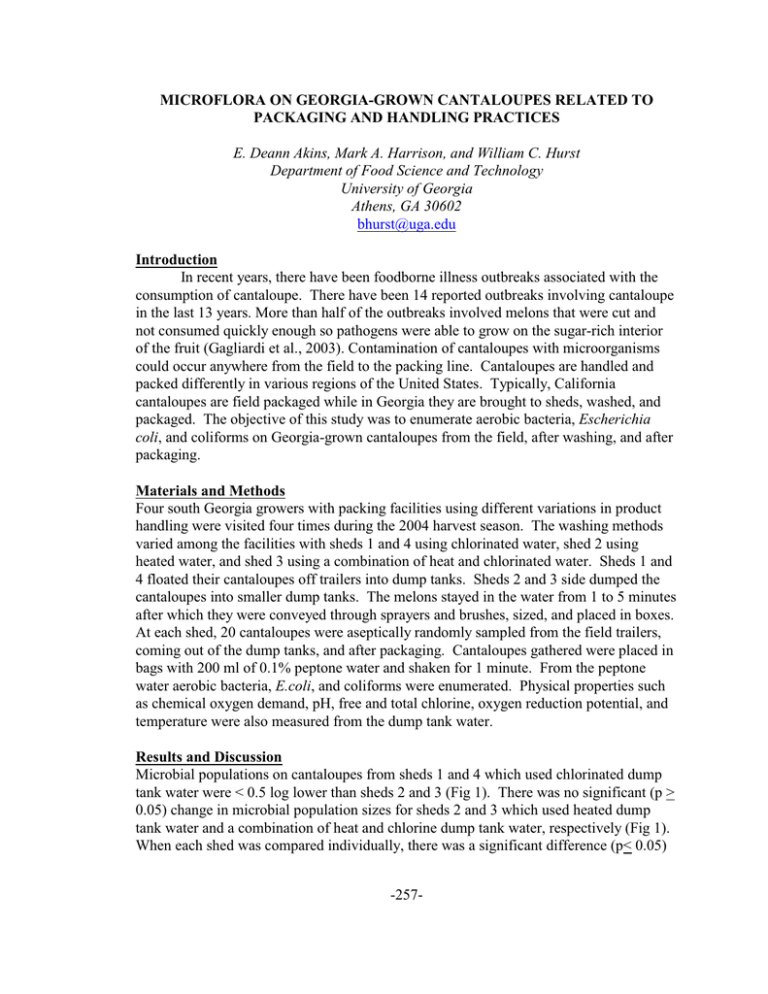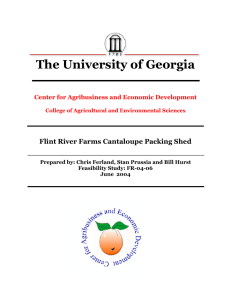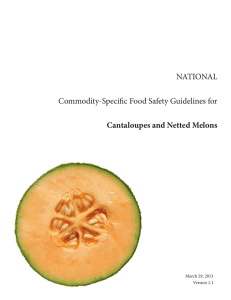MICROFLORA ON GEORGIA-GROWN CANTALOUPES RELATED TO PACKAGING AND HANDLING PRACTICES
advertisement

MICROFLORA ON GEORGIA-GROWN CANTALOUPES RELATED TO PACKAGING AND HANDLING PRACTICES E. Deann Akins, Mark A. Harrison, and William C. Hurst Department of Food Science and Technology University of Georgia Athens, GA 30602 bhurst@uga.edu Introduction In recent years, there have been foodborne illness outbreaks associated with the consumption of cantaloupe. There have been 14 reported outbreaks involving cantaloupe in the last 13 years. More than half of the outbreaks involved melons that were cut and not consumed quickly enough so pathogens were able to grow on the sugar-rich interior of the fruit (Gagliardi et al., 2003). Contamination of cantaloupes with microorganisms could occur anywhere from the field to the packing line. Cantaloupes are handled and packed differently in various regions of the United States. Typically, California cantaloupes are field packaged while in Georgia they are brought to sheds, washed, and packaged. The objective of this study was to enumerate aerobic bacteria, Escherichia coli, and coliforms on Georgia-grown cantaloupes from the field, after washing, and after packaging. Materials and Methods Four south Georgia growers with packing facilities using different variations in product handling were visited four times during the 2004 harvest season. The washing methods varied among the facilities with sheds 1 and 4 using chlorinated water, shed 2 using heated water, and shed 3 using a combination of heat and chlorinated water. Sheds 1 and 4 floated their cantaloupes off trailers into dump tanks. Sheds 2 and 3 side dumped the cantaloupes into smaller dump tanks. The melons stayed in the water from 1 to 5 minutes after which they were conveyed through sprayers and brushes, sized, and placed in boxes. At each shed, 20 cantaloupes were aseptically randomly sampled from the field trailers, coming out of the dump tanks, and after packaging. Cantaloupes gathered were placed in bags with 200 ml of 0.1% peptone water and shaken for 1 minute. From the peptone water aerobic bacteria, E.coli, and coliforms were enumerated. Physical properties such as chemical oxygen demand, pH, free and total chlorine, oxygen reduction potential, and temperature were also measured from the dump tank water. Results and Discussion Microbial populations on cantaloupes from sheds 1 and 4 which used chlorinated dump tank water were < 0.5 log lower than sheds 2 and 3 (Fig 1). There was no significant (p > 0.05) change in microbial population sizes for sheds 2 and 3 which used heated dump tank water and a combination of heat and chlorine dump tank water, respectively (Fig 1). When each shed was compared individually, there was a significant difference (p< 0.05) -257- between sheds 1 and 4 compared with sheds 2 and 3 for both E.coli and coliform counts (Table 1 & 2). Aerobic populations after packing were approximately the same as that from cantaloupes sampled from the field. The E.coli and coliform populations were the lowest on cantaloupes from the field. Populations of E. coli and coliforms increased after washing and increased again after packing. Carbon oxygen demand of the dump tank water ranged from 0 to 291 mg/L. The oxygen reduction potential of the dump tank water ranged from 151 to 704 mV. The pH of the dump tank water varied from 7.4 to 8.7. Free chlorine measurements of the dump tank water were between undetectable to 37 ppm and total chlorine measured between 0 to 50 ppm. Water temperatures from shed 2 ranged from 25- 57°C and shed 3's water temperature varied from 27-41°C. Because the areobic populations on the cantaloupes were approximately the same for each shed and the E.coli, and coliform populations increased during the actual field packing conditions, there is no microbial reduction from the dump tank treatment of cantaloupes. References Gagliardi, J.V., P.D. Millner, G. Lester, D. Ingram. 2003. On-Farm and Postharvest Processing Sources of Bacterial Contamination to Melon Rinds. Journal of Food Protection. 66:1:82-87. -258- Figure 1. Average log aerobic population (cfu/ml) on cantaloupe surfaces sampled from the field, dump tank, and packing stages at four different packing sheds (n=870). -259- Table 1. Proportion of samples positive for E. coli to those that were negative (<15cfu/ml). Letters x,y and z in the same row differ significantly (p<0.05). Letters a and b in the same column differ significantly (p<0.05). Field Dump tank Shed 2 (n=239) x 0.125a y Shed 3 (n=180) x 0.000a y Shed 4 (n=238) x 0.128b y Shed 1 (n=209) x 0.114b y Packing 0.200a z 0.329a 0.133a z 0.583a 0.088b z 0.138b 0.129b z 0.072b Table 2. Average log counts of coliform bacteria (cfu/ml) on cantaloupe surfaces sampled from the field, dump tank, and packing stages at four different packing sheds, (SD=3.44). Letters x,y and z in the same row differ significantly (p<0.05). Letters a and b in the same column differ significantly (p<0.05). Shed 2 (n=239) Field x2.69a Dump tank y4.71a Shed 3 (n=180) x 1.20a y Shed 4 (n=237) x 1.48b y Shed 1(n=209) x 2.05b y -260- Packing z6.44a 3.03a z 9.21a 1.40b z 5.35b 1.13b z 3.05b







